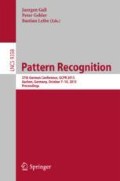Abstract
Physics-based modeling is a powerful tool for human gait analysis and synthesis. Unfortunately, its application suffers from high computational cost regarding the solution of optimization problems and uncertainty in the choice of a suitable objective energy function and model parametrization. Our approach circumvents these problems by learning model parameters based on a training set of walking sequences. We propose a combined representation of motion parameters and physical parameters to infer missing data without the need for tedious optimization. Both a k-nearest-neighbour approach and asymmetrical principal component analysis are used to deduce ground reaction forces and joint torques directly from an input motion. We evaluate our methods by comparing with an iterative optimization-based method and demonstrate the robustness of our algorithm by reducing the input joint information. With decreasing input information the combined statistical model regression increasingly outperforms the iterative optimization-based method.
References
Al-Naser, M., Söderström, U.: Reconstruction of occluded facial images using asymmetrical principal component analysis. Integr. Comput. Aided Eng. 19(3), 273–283 (2012)
Boiman, O., Shechtman, E., Irani, M.: In defense of nearest-neighbor based image classification. In: CVPR. IEEE Computer Society (2008)
Brubaker, M.A., Fleet, D.J.: The kneed walker for human pose tracking. In: IEEE Conference on Computer Vision and Pattern Recognition (2008)
Brubaker, M.A., Sigal, L., Fleet, D.J.: Estimating contact dynamics. In: IEEE 12th International Conference on Computer Vision, ICCV 2009, September 27 - October 4 2009, Kyoto, Japan, pp. 2389–2396 (2009)
Chow, C.K., Jacobson, D.: Studies of human locomotion via optimal programming. Math. Biosci. 10(3–4), 239–306 (1971)
Fregly, B.J., Reinbolt, J.A., Rooney, K.L., Mitchell, K.H., Chmielewski, T.L.: Design of patient-specific gait modifications for knee osteoarthritis rehabilitation. IEEE Trans. Biomed. Eng. 54(9), 1687–1695 (2007)
Jiang, Z., Lin, Z., Davis, L.S.: Learning a discriminative dictionary for sparse coding via label consistent K-SVD. In: 2011 IEEE Conference on Computer Vision and Pattern Recognition (CVPR), pp. 1697–1704 (2011)
Liu, C.K., Hertzmann, A., Popović, Z.: Learning physics-based motion style with nonlinear inverse optimization. ACM Trans. Graph. 24(3), 1071–1081 (2005)
Powers, C.M.: The influence of abnormal hip mechanics on knee injury: a biomechanical perspective. JOSPT 40, 42–51 (2010)
Rao, G., Amarantini, D., Berton, E., Favier, D.: Influence of body segments’ parameters estimation models on inverse dynamics solutions during gait. J. Biomech. 39(8), 1531–1536 (2006)
Schmalz, T., Blumentritt, S., Jarasch, R.: Energy expenditure and biomechanical characteristics of lower limb amputee gait: the influence of prosthetic alignment and different prosthetic components. Gait Posture 16(3), 255–263 (2002)
Schmidt, N., Okada, M.: Optimal design of nonlinear springs in robot mechanism: simultaneous design of trajectory and spring force profiles. Adv. Robot. 27(1), 33–46 (2013)
Sok, K.W., Kim, M., Lee, J.: Simulating biped behaviours from human motion data. In: Proceedings of the ACM SIGGRAPH 2007, p. 107 (2007)
Troje, N.F.: Decomposing biological motion: a framework for analysis and synthesis of human gait patterns. J. Vis. 2(5), 371–387 (2002)
Tsai, Y.Y., Lin, W.C., Cheng, K.B., Lee, J., Lee, T.Y.: Real-time physics-based 3d biped character animation using an inverted pendulum model. IEEE Trans. Vis. Comput. Graph. 16(2), 325–337 (2010)
Vaughan, C.L.: Are joint torques the holy grail of human gait analysis? Hum. Mov. Sci. 15(3), 423–443 (1996)
Wei, X., Min, J., Chai, J.: Physically valid statistical models for human motion generation. ACM Trans. Graph. 30(3), 19:1–19:10 (2011)
Whittle, M.W.: Clinical gait analysis: a review. Hum. Mov. Sci. 15(3), 369–387 (1996)
Wright, J., Yang, A.Y., Ganesh, A., Sastry, S.S., Ma, Y.: Robust face recognition via sparse representation. IEEE Trans. Pattern Anal. Mach. Intell. 31(2), 210–227 (2009)
Xiang, Y., Arora, J.S., Abdel-Malek, K.: Optimization-based prediction of asymmetric human gait. J. Biomech. 44(6), 683–693 (2011)
Yin, K., Loken, K., van de Panne, M.: Simbicon: simple biped locomotion control. ACM Trans. Graph. 26(3) (2007)
Author information
Authors and Affiliations
Corresponding author
Editor information
Editors and Affiliations
Rights and permissions
Copyright information
© 2015 Springer International Publishing Switzerland
About this paper
Cite this paper
Zell, P., Rosenhahn, B. (2015). A Physics-Based Statistical Model for Human Gait Analysis. In: Gall, J., Gehler, P., Leibe, B. (eds) Pattern Recognition. DAGM 2015. Lecture Notes in Computer Science(), vol 9358. Springer, Cham. https://doi.org/10.1007/978-3-319-24947-6_14
Download citation
DOI: https://doi.org/10.1007/978-3-319-24947-6_14
Published:
Publisher Name: Springer, Cham
Print ISBN: 978-3-319-24946-9
Online ISBN: 978-3-319-24947-6
eBook Packages: Computer ScienceComputer Science (R0)

